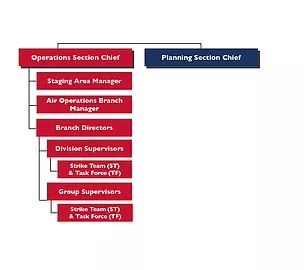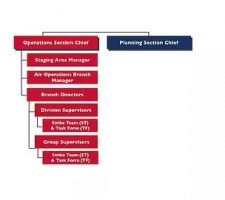 The Operations Section is the focal point of the management of an incident so the importance of developing and maintaining an effective and efficient Operations Section organization cannot be overstated. Unfortunately, incident organizing is a skill that many existing or up-and-coming Operations Section Chiefs and Deputy Operations Section Chiefs need to continually work at and practice their proficiency. It is not at all uncommon to see students struggle over developing their Operations Section organization during ICS training courses.
The Operations Section is the focal point of the management of an incident so the importance of developing and maintaining an effective and efficient Operations Section organization cannot be overstated. Unfortunately, incident organizing is a skill that many existing or up-and-coming Operations Section Chiefs and Deputy Operations Section Chiefs need to continually work at and practice their proficiency. It is not at all uncommon to see students struggle over developing their Operations Section organization during ICS training courses.
Why is this when the success of the entire incident depends so much on the success of the Operations Section? One reason is that while most emergency responders understand the fundamentals and purpose of branches, divisions, groups, strike teams, and task forces, they do not get enough experience in training or on actual incidents to become proficient using these ICS tools. It can be challenging for the Operations Section Chief to design an Operations organization quickly and effectively, and within Command’s directions and constraints. Let’s face it, outside the wildland fire community there are not a lot of incidents with opportunities to develop complex, multi-branch operations sections with multiple functional activities. Consequently, developing this skill is difficult and may take many years. Practicing these methods in exercises is a good alternative to waiting for the infrequent real thing.
A second reason for ineffective Operations Section organization can be from jumping right in at the branch, division, or group level. This is understandable because Operations Section Chiefs can be under great pressure to design an effective organization during the initial phase of an incident and these are the tools most frequently emphasized in ICS training. But this is in effect building the operations organization from the top down or at least the middle down. This may lock them into a larger organization then necessary requiring more overhead for excessive organizational levels and continued reorganization to maintain its effectiveness.
There are two key principles to remember when organizing the Operations Section. The first is the principle that the Operations Section builds from the bottom up, unlike the overall incident management that begins with an Incident Commander and then expands downward. The second principle is “span of control” or the number of resources one person can effectively manage.
That number is commonly recognized to be 3 to 7, with 5 being the optimum number. Using these two principles properly, an Operations Section Chief with the technical knowledge of the incident can develop an effective organization that neither over-organizes nor under-organizes and still maintains the capability to grow the organization if necessary. It is important to begin your initial organization as lean as possible to allow the Operations Section to expand to meet the needs of the incident.
One of the most straightforward ways for the Operations Section Chief to begin organizing the section is to start at the lowest level possible, forming single resources into strike teams and task forces as applicable until the span of control is reached. A strike team/task force leader can usually be appointed from among the single resource leadership, thus saving the cost of ordering expensive overhead. Once the span of control is reached at this level, the Operations Section Chief can then establish divisions and groups with multiple strike teams or task forces, as appropriate, and single resources assigned to each. When span of control limits are reached at the division or group level, the Operations Section Chief can add branches and continue to grow the organization.
In this manner, the Operations Section is building from the bottom up. Expansion can continue from the bottom up, adding supervisory elements whenever necessary to stay within span of control parameters. This decision making process may not work in every instance, but should at least be considered by the Operations Section Chief when designing the Operations organization.
Remember, when organizing the Operations Section, there are a number of benefits to building the Operations Section from the bottom up within span of control rather then immediately establishing branches, divisions, and groups and building from the top down:
1. Keeps the Operations Section as lean as possible without under-organizing.
2. Doesn’t over-organize the section with unnecessary branches,divisions or groups.
3. Saves ordering unnecessary overhead personnel.
4. Helps to maximize the number of resources that can be effectively managed in an incident.
This looks and sounds easy, but the proof is doing it under the stress of actual incident conditions. That’s why we emphasize this in our ICS-320 and ICS-430 courses. The more an Operations Section Chief and their deputies can develop this
skill, the quicker they can develop their organization on the incident scene to accomplish Command’s objectives safely and effectively. Beginning your organization at the lowest possible level will allow for an easier expansion as the Operations Section grows and allow more resources to be effectively used during the management of the incident.
To read more about the author, Jim Strickland, click here!


